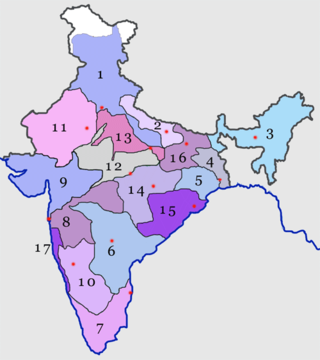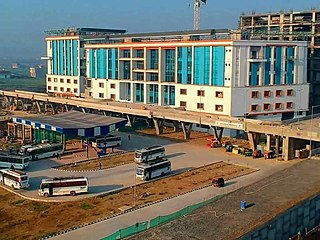
The Delhi Transport Corporation(DTC) is a public sector passenger road transport corporation that manages bus services in Delhi, India. It was incorporated in November 1971 as a wholly owned Corporation of the Government of India under Section 3 of the Road Transport Corporations Act, 1950, to provide an efficient, economical and properly coordinated road transport service in Delhi. Its administrative control was transferred to the Department of Transport, Government of Delhi with effect from 5 August 1996.
The Mudrika Seva is one of the most popular bus routes in Delhi, India. It was started by the Delhi Transport Corporation (DTC) in May 1974, and is now operated by both the Corporation and DIMTS' cluster buses. The service runs on Delhi's inner ring road, with major stops at AIIMS, Lajpat Nagar, Sarai Kale Khan, ITO, Delhi Gate, Kashmere Gate, DU North Campus, Model Town, Azadpur market, Shalimar Bagh, Punjabi Bagh, Britannia Factory, Rajouri Garden, Naraina, and DU South Campus.

The Northern Railway (NR) is one of the 19 Railway zones of India and the northernmost zone of the Indian Railways. It is headquartered at Baroda House in New Delhi.
Sarai Kale Khan is a village in South East Delhi district in Delhi.This place is remotely connected to other parts of Delhi through the means of Delhi Metro Pink Line. It also has Inter-State Bus Terminus. It is adjacent to the Hazrat Nizamuddin Railway Station. It is one of the five main stations in Delhi and is the originating and terminal station for 60 trains. Sarai Kale Khan is the terminus for most buses heading for towns south of Delhi. It is also a DTC bus depot for the Mudrika Seva and many other bus routes.

The Inner Ring Road refers to one of the two main ring roads, the main inner one and an outer one in Delhi, India. The two ring roads have a combined length of 87 km (54 mi). There are two less significant Ring Roads in Delhi apart from the above two, namely the Rural Ring Road, that runs across the rural areas on the fringe of North West Delhi and West Delhi Ring Road, limited only to the West Delhi region.

Kashmiri Gate or Kashmere Gate is a gate located in Old Delhi in UT of Delhi, India. it is the northern gate to the historic walled city of Old Delhi. Built by the Mughal Emperor Shah Jahan, the gate is so named because it was at the start of a road that led to Kashmir.

Delhi has significant reliance on its transport infrastructure. The city has developed a highly efficient public transport system with the introduction of the Delhi Metro, which is undergoing a rapid modernization and expansion since 2006. There are 16.6 million registered vehicles in the city as of 30 June 2014, which is the highest in the world among all cities, most of which do not follow any pollution emission norm, while the Delhi metropolitan region has 11.2 million vehicles. Delhi and NCR lose nearly 42 crore man-hours every month while commuting between home and office through public transport, due to the traffic congestion. Therefore, serious efforts, including a number of transport infrastructure projects, are under way to encourage usage of public transport in the city.
In India, an Inter State Bus Terminal or Inter-State Bus Terminus (ISBT) is a bus terminus that provides bus service to destinations located in other states. An ISBT may also provide bus services to destinations in the same state. Mostly ISBT Term is used in the Northern Part of India, In the western part of India, ST Stand or State Transport Term is used.

Hazrat Nizamuddin railway station is a railway station in South Delhi, India. It is under the administrative control of the Delhi Division of the Northern Railway zone of the Indian Railways. It is one of the five main stations in Delhi and handles nearly 250 trains daily The station was named after the Sufi saint Hazrat Nizamuddin. Hazrat Nizamuddin station was upgraded to help relieve congestion at New Delhi railway station and is recommended for first-time travellers, particularly those bound for Agra, as it is less busy and easier to navigate.

Kashmere Gate, also known as Kashmiri Gate, is an important metro station on Delhi Metro in Delhi, which is elevated for the Red Line and underground for both the Yellow Line and Violet Line. It is a transfer station between the Red Line on the highest upper level, the Yellow Line on the lowest underground level and Violet Line on the parallel underground level. It is the busiest metro station in India. It was named on 25 December 2002. During peak hours, it serves as an alternate Northern Terminus for the yellow line along with Vishwa Vidyalaya.

Anand Vihar is an interchange metro station located on the Blue Line and the Pink Line of Delhi Metro. The station is located in the Anand Vihar locality near the interstate border between Delhi and Uttar Pradesh and is a major connectivity hub of East Delhi. It is connected to the Anand Vihar ISBT and Anand Vihar Railway Terminal.

The Dwarka Sector 21 metro station, on the Blue Line and Orange Line of the Delhi Metro, is a major metro and multimodal interchange station with adjacent Dwarka ISBT Bus Terminal in the west and Bijwasan railway station in the east.
The Veer Hakikat Rai Interstate Bus Terminus (Veer Hakikat Rai ISBT), popularly known as Sarai Kale Khan Interstate Bus Terminus (Sarai Kale Khan ISBT), located in Delhi is one of the three Inter State Bus Terminals in Delhi. It operates bus services between Delhi and the neighbouring states of Haryana and Rajasthan.

The Sarai Kale Khan - Nizamuddin metro station is located on the Pink Line of the Delhi Metro. It was opened on 31 December 2018 as part of Phase III of Delhi Metro.

The Swami Vivekanand Interstate Bus Terminus (Swami Vivekanand ISBT), popularly known as Anand Vihar Interstate Bus Terminus (Anand Vihar ISBT), located in Delhi is one of the three Inter State Bus Terminals in Delhi. It operates bus services between Delhi and the neighbouring states of Uttar Pradesh and Uttarakhand.
Bijwasan railway station, on Delhi-Jaipur line lies immediate southwest of Delhi's main airport the IGI Airport, in Bijwasan in South Delhi in India. The station, part of Delhi Suburban Railway, is being upgraded to the world class regional multimodal interchange for the IGI airport by 2024. It will connect to the Haryana Orbital Rail Corridor in south at Patli railway station.
The Sarwate Inter-state bus terminus popularly known as Sarwate Bus Stand or ISBT, located in Indore is the oldest and one of the biggest Inter State Bus Terminals in Indore. It operates bus services between Indore and 5 other states, Rajasthan, Gujarat, Uttar Pradesh, Maharashtra and Chhattisgarh. Spread over an area of about 1 acre, it handles over 1800 buses a day.
The Gangwal Inter-state bus terminus popularly known as Gangwal Bus Stand or ISBT, located in Indore is one of the oldest and one of the biggest Inter State Bus Terminals in Indore. It operates bus services between Indore and 2 other states, Rajasthan, Gujarat.

The Patliputra Inter-State Bus Terminal or Bairiya Bus Terminal is an Inter State Bus Terminal (ISBT) in Patna, Bihar, India. It is the first ISBT of Bihar and is situated on State Highway 1 (SH-1) between Raman Chak and Pahari village in Patna. The Patliputra ISBT was inaugurated on 18 September 2020.
Sarai Kale Khan RRTS station is an under construction RRTS station in South East Delhi district, Delhi, India which will serves mainly higher-speed trains. It will serve as the terminus for higher-speed trains on the Delhi–Meerut Regional Rapid Transit System that can reach speeds of up to 180 km/h. This station will serve as a Terminus station on the 3 priority RRTS corridors of the first phase.















